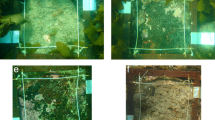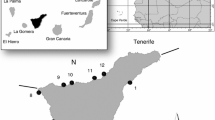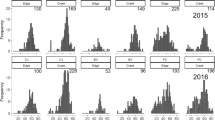Abstract
We examined, over 2 years, factors affecting the temporal stability of the lower limit of kelp beds (Alaria esculenta) at five subtidal sites in the Mingan Islands, northern Gulf of St. Lawrence. The position of the lower limit of the beds varied markedly among sites and over time and was largely controlled by the green sea urchin, Strongylocentrotus droebachiensis, which formed dense (up to 500 individuals m−2) feeding fronts at the lower edge of the beds. These aggregations advanced over the kelp most rapidly during the summer (at rates as high as 2.5 m month−1), and there appeared to be a threshold urchin biomass of ~5 kg m−2 below which the fronts could not substantially reduce the limit of the beds. The fronts consisted mainly of large individuals, whereas smaller urchins predominated in the barrens zone below the kelp beds. At one site, we recorded large seasonal shifts in overall urchin densities, with large increases and decreases during the summer and winter, respectively. An urchin exclusion experiment indicated that algal recruitment in the barrens was two orders of magnitude greater in the absence than in the presence of urchins. The kelp Agarum cribrosum greatly restricted urchin movements, and the greater temporal stability of the kelp bed at one site appeared related to the gradual replacement of Alaria esculenta in the lower kelp bed by a large stand of Agarum cribrosum. We propose that perturbations by abiotic factors (e.g., ice scouring and water motion) trigger important but localized changes in urchin densities that, in turn, largely determine the limits of kelp bed distribution in this region of the Atlantic where urchin barrens are a persistent community state.








Similar content being viewed by others
References
Archambault D, Bourget E (1983) Importance du régime de dénudation sur la structure et la succession des communautés intertidales de substrat rocheux en milieu subarctique. Can J Fish Aquat Sci 40:1278–1292
Balch T, Scheibling RE (2000) Temporal and spatial variability in settlement and recruitment of echinoderms in kelp beds and barrens in Nova Scotia. Mar Ecol Prog Ser 205:139–154
Bégin C, Johnson LE, Himmelman JH (2003) Macroalgal canopies: patterns of distribution and diversity of associated invertebrates and effects on the recruitment and growth of mussels. Mar Ecol Prog Ser (in press)
Bergeron P, Bourget E (1984) Effet du froid et des glaces sur les peuplements intertidaux des régions nordiques particulièrement dans l’estuaire du Saint-Laurent. Oceanis 10:279–304
Bernstein BB, Williams BE, Mann KH (1981) The role of behavioral responses to predators in modifying urchins’ (Strongylocentrotus droebachiensis) destructive grazing and seasonal foraging patterns. Mar Biol 63:39–49
Bourget E, Archambault D, Bergeron P (1985) Effet des propriétés hivernales sur les peuplements épibenthiques intertidaux dans un milieu subarctique, l’estuaire du Saint-Laurent. Nat Can 112:131–142
Breen PA, Mann KH (1976a) Changing lobster abundance and the destruction of kelp beds by sea urchins. Mar Biol 34:137–142
Breen PA, Mann KH (1976b) Destructive grazing of kelp by sea urchins in eastern Canada. J Fish Res Bd Can 33:1278–1283
Chapman ARO (1981) Stability of sea urchin dominated barren grounds following destructive grazing of kelp in St. Margaret’s Bay, eastern Canada. Mar Biol 62:307–311
Chapman ARO, Johnson CR (1990) Disturbance and organization of macroalgal assemblages in the northwest Atlantic. Hydrobiologia 192:77–121
Cowen RK, Agegian CR, Foster MS (1982) The maintenance of community structure in a central California giant kelp forest. J Exp Mar Biol Ecol 64:189–201
Crowder MJ, Hand DJ (1990) Analysis of repeated measures. Chapman & Hall, London
Dayton PK (1985a) The structure and regulation of some South American kelp communities. Ecol Monogr 55:447–468
Dayton PK (1985b) Ecology of kelp communities. Annu Rev Ecol Syst 16:215–245
Dean TA, Schroeter SC, Dixon JD (1984) Effects of grazing by two species of sea urchins (Strongylocentrotus franciscanus and Lytechinus anamesus) on recruitment and survival of two species of kelp (Macrocystis pyrifera and Pterygophora californica). Mar Biol 78:301–313
Draper NR, Smith H (1981) Applied regression analysis. Wiley, New York
Duggins DO (1980) Kelp beds and sea otters: an experimental approach. Ecology 61:447–453
Duggins DO, Eckman JE, Sewell AT (1990) Ecology of understory kelp environments II. Effects of kelps on recruitment of benthic invertebrates. J Exp Mar Biol Ecol 143:27–45
Ebeling AW, Laur DR, Rowley RJ (1985) Severe storm disturbances and reversal of community structure in a southern California kelp forest. Mar Biol 84:287–294
Estes JA, Smith NS, Palmisano JF (1978) Sea otter predation and community organization in the western Aleutian Islands, Alaska. Ecology 59:822–833
Gagnon P, Himmelman JH, Johnson LE (2003a) Algal colonization in urchin barrens: defense by association during recruitment of the brown alga Agarum cribrosum. J Exp Mar Biol Ecol 290:179–196
Gagnon P, Wagner G, Himmelman JH (2003b) Use of a wave tank to study the effects of water motion and algal movement on the displacement of the sea star Asterias vulgaris towards its prey. Mar Ecol Prog Ser 258:125–132
Hagen NT (1983) Destructive grazing of kelp beds by sea urchins in Vestfjorden, northern Norway. Sarsia 68:177–190
Hand DJ, Taylor CC (1987) Multivariate analysis of variance and repeated measures. Chapman & Hall, London
Himmelman JH (1984) Urchin feeding and macroalgal distribution in Newfoundland, eastern Canada. Nat Can 111:337–348
Himmelman JH, Lavergne Y (1985) Organization of rocky subtidal communities in the St. Lawrence Estuary. Nat Can 112:143–154
Himmelman JH, Nédélec H (1990) Urchin foraging and algal survival strategies in intensely grazed communities in eastern Canada. Can J Fish Aquat Sci 47:1011–1026
Himmelman JH, Steele DH (1971) Foods and predators of the green sea urchin Strongylocentrotus droebachiensis in Newfoundland waters. Mar Biol 9:315–322
Himmelman JH, Cardinal A, Bourget E (1983) Community development following removal of urchins, Strongylocentrotus droebachiensis, from the rocky subtidal zone of the St. Lawrence Estuary, eastern Canada. Oecologia 59:27–39
Hooper R (1981) Recovery of Newfoundland benthic marine communities from sea ice. Proc Int Seaweed Symp 8:360–366
Kawamata S (1998) Effect of wave-induced oscillatory flow on grazing by a subtidal sea urchin Strongylocentrotus nudus (A. Agassiz). J Exp Mar Biol Ecol 224:31–48
Kawamata S (2001) Adaptive mechanical tolerance and dislodgement velocity of the kelp Laminaria japonica in wave-induced water motion. Mar Ecol Prog Ser 211:89–104
Keats DW, South GR, Steele DH (1982) The occurrence of Agarum cribrosum (Mert.) Bory (Phaeophyta, Laminariales) in relation to some of its competitors and predators in Newfoundland. Phycologia 21:189–191
Keats DW, South GR, Steele DH (1985) Algal biomass and diversity in the upper subtidal at a pack-ice disturbed site in eastern Newfoundland. Mar Ecol Prog Ser 25:151–158
Keats DW, South GR, Steele DH (1990) Effects of an experimental reduction in grazing by green sea urchins on a benthic macroalgal community in eastern Newfoundland. Mar Ecol Prog Ser 68:181–193
Konar B (2000) Seasonal inhibitory effects of marine plants on sea urchins: structuring communities the algal way. Oecologia 125:208–217
Larson BR, Vadas RL, Keser M (1980) Feeding and nutritional ecology of the sea urchin Strongylocentrotus drobachiensis in Maine, USA. Mar Biol 59:49–62
Lawrence JM (1975) On the relationships between marine plants and sea urchins. Oceanogr Mar Biol Annu Rev 13:213–286
Leinaas HP, Christie H (1996) Effects of removing sea urchins (Strongylocentrotus droebachiensis): stability of the barren state and succession of kelp forest recovery in the east Atlantic. Oecologia 105:524–536
Lobban CS, Harrison PJ (1994) Seaweed ecology and physiology. Cambridge University Press, Cambridge
Mann KH (1973) Seaweeds: their productivity and strategy for growth. Science 182:975–981
Mann KH (1977) Destruction of kelp-beds by sea-urchins: a cyclical phenomenon or irreversible degradation? Helgol Wiss Meeresunters 30:455–467
Meidel SK, Scheibling RE (1998) Annual reproductive cycle of the green sea urchin, Strongylocentrotus droebachiensis, in differing habitats in Nova Scotia, Canada. Mar Biol 131:461–478
Meidel SK, Scheibling RE (1999) Effects of food type and ration on reproductive maturation and growth of the sea urchin Strongylocentrotus droebachiensis. Mar Biol 134:155–166
Miller RJ (1985) Succession in sea urchin and seaweed abundance in Nova Scotia, Canada. Mar Biol 84:275–286
Miller RJ, Colodey AG (1983) Widespread mass mortalities of the green sea urchin in Nova Scotia, Canada. Mar Biol 73:263–267
Minor MA, Scheibling RE (1997) Effects of food ration and feeding regime on growth and reproduction of the sea urchin Strongylocentrotus droebachiensis. Mar Biol 129:159–167
Paine RT, Vadas RL (1969) The effects of grazing by sea urchins, Strongylocentrotus spp., on benthic algal populations. Limnol Oceanogr 14:710–719
Pearse JS, Hines AH (1979) Expansion of a central California kelp forest following the mass mortality of sea urchins. Mar Biol 51:83–91
Raymond BG, Scheibling RE (1987) Recruitment and growth of the sea urchin Strongylocentrotus droebachiensis (Muller) following mass mortalities off Nova Scotia, Canada. J Exp Mar Biol Ecol 108:31–54
Russell MP, Ebert TA, Petraitis PS (1998) Field estimates of growth and mortality of the green sea urchin, Strongylocentrotus droebachiensis. Ophelia 48:137–153
SAS Institute Inc. (1999) SAS/STAT User’s Guide, vers 8. SAS Institute, Cary, N.C.
Scheibling R (1986) Increased macroalgal abundance following mass mortalities of sea urchins (Strongylocentrotus droebachiensis) along the Atlantic coast of Nova Scotia. Oecologia 68:186–198
Scheibling RE (1988) Microbial control of sea urchins: Achilles’ heel or Pandora’s box? In: Burke RD, Mladenov PV, Lambert P, Parsley RL (eds) Echinoderm biology. Balkema, Rotterdam, pp 745–754
Scheibling RE (1996) The role of predation in regulating sea urchin populations in eastern Canada. Oceanol Acta 19:421–430
Scheibling RE, Hatcher BG (2001) The ecology of Strongylocentrotus droebachiensis. In: Lawrence JM (ed) Edible sea urchins: biology and ecology. Elsevier, Amsterdam, pp 271–306
Scheibling RE, Hennigar AW (1997) Recurrent outbreaks of disease in sea urchins Strongylocentrotus droebachiensis in Nova Scotia: evidence for a link with large-scale meteorologic and oceanographic events. Mar Ecol Prog Ser 152:155–165
Scheibling RE, Stephenson RL (1984) Mass mortality of Strongylocentrotus droebachiensis (Echinodermata: Echinoidea) off Nova Scotia, Canada. Mar Biol 78:153–164
Scheibling RE, Hennigar AW, Balch T (1999) Destructive grazing, epiphytism, and disease: the dynamics of sea urchin-kelp interactions in Nova Scotia. Can J Fish Aquat Sci 56:2300–2314
Sebens KP (1985) Community ecology of vertical rock walls in the Gulf of Maine, U.S.A.: small-scale processes and alternative community states. In: Moore PG, Seed R (eds) The ecology of rocky coasts. Hodder and Stoughton, London, pp 346–371
Seymour RJ, Tegner MJ, Dayton PK, Parnell PE (1989) Storm wave induced mortality of giant kelp, Macrocystis pyrifera, in southern California. Estuar Coast Shelf Sci 28:277–292
Simenstad CA, Estes JA, Kenyon KW (1978) Aleuts, sea otters, and alternate stable-state communities. Science 200:403–411
Sivertsen K (1997) Geographic and environmental factors affecting the distribution of kelp beds and barren grounds and changes in biota associated with kelp reduction at sites along Norwegian coast. Can J Fish Aquat Sci 54:2872–2887
Snedecor GW, Cochran WG (1989) Statistical methods. Iowa State University Press, Ames
Steneck RS (1983) Escalating herbivory and resulting adaptive trends in calcareous algal crusts. Paleobiology 9:44–61
Steneck RS (1986) The ecology of coralline algal crusts: convergent patterns and adaptative strategies. Annu Rev Ecol Syst 17:273–303
Swan EF (1961) Some observations on the growth rate of sea urchins in the genus Strongylocentrotus. Biol Bull 120:420–427
Tegner MJ, Dayton PK (2000) Ecosystem effects of fishing in kelp forest communities. ICES J Mar Sci 57:579–589
Thompson RJ (1984) Partitioning of energy between growth and reproduction in three populations of the green sea urchin Strongylocentrotus droebachiensis. Adv Invert Reprod 3:425–432
Vadas RL (1968) The ecology of Agarum and the kelp bed community. PhD thesis, University of Washington, Seattle
Vadas RL (1977) Preferential feeding: an optimization strategy in sea urchins. Ecol Monogr 47:337–371
Vadas RL, Elner RW (1992) Plant-animal interactions in the north-west Atlantic. In: John DM, Hawkins SJ, Price JH (eds) Plant-animal interactions in the marine benthos, Oxford University Press, Oxford, pp 33–60
Vasquez JA (1993) Effects on the animal community of dislodgment of holdfasts of Macrocystis pyrifera. Pac Sci 47:180–184
Vasquez JA, Buschmann AH (1997) Herbivore-kelp interactions in Chilean subtidal communities: a review. Rev Chil Hist Nat 70:41–52
Vasquez JA, McPeak RH (1998) A new tool for kelp restoration. Calif Fish Game 84:149–158
Velimirov B, Griffiths CL (1979) Wave-induced kelp movement and its importance for community structure. Bot Mar 22:169–172
Witman JD (1985) Refuges, biological disturbance, and rocky subtidal community structure in New England. Ecol Monogr 55:421–445
Witman JD (1987) Subtidal coexistence: storms, grazing, mutualism and the zonation of kelps and mussels. Ecol Monogr 57:167–187
Zar JH (1999) Biostatistical analysis. Prentice-Hall, Upper Saddle River, N.J.
Acknowledgements
We are grateful to N. Cormier, D. Aiello, O. D’Amours, I. Deschênes, M. Dionne, D. Drolet, A. Drouin, S.-P. Gingras, M. Guay, V. Messier, M.-O. Nadon, L.V. St-Hilaire-Gravel, M. Thompson, and G. Wagner for their unflagging assistance during numerous long dives in cold, shallow waters, and to J.-M. Daigle for statistical advice. This research was funded by NSERC (Natural Sciences and Engineering Research Council of Canada) and FCAR (Fonds pour la Formation de Chercheurs et l’Aide à la Recherche) grants to J.H.H. and L.E.J., and P.G. was supported by scholarships from NSERC and Québec-Océan.
Author information
Authors and Affiliations
Corresponding author
Additional information
Communicated by R.J. Thompson, St. John’s
Rights and permissions
About this article
Cite this article
Gagnon, P., Himmelman, J.H. & Johnson, L.E. Temporal variation in community interfaces: kelp-bed boundary dynamics adjacent to persistent urchin barrens. Marine Biology 144, 1191–1203 (2004). https://doi.org/10.1007/s00227-003-1270-x
Received:
Accepted:
Published:
Issue Date:
DOI: https://doi.org/10.1007/s00227-003-1270-x




